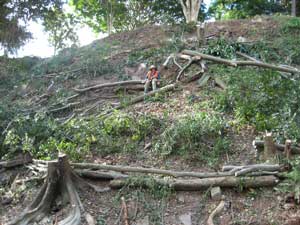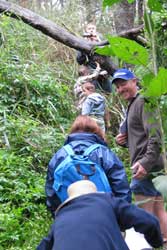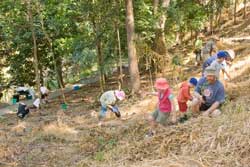 |
Background
Site characteristics
Implementation
Into the future...
Background
Late in 2008, the Kedron Brook Catchment Branch (KBCB) was awarded a grant to undertake a habitat restoration project on the northern banks of Kedron Brook in Kalinga Park (Nundah). This project was made possible through funding from the Australian Governments Caring for Our Country.
The original impetus for this project was a weed “blitz” undertaken by Brisbane City Council following safety concerns in this stretch of the Kedron Brook bikeway and pathway network. After the weeds had been removed, it revealed just how much of this bushland was weed infested and also the steep gradient of much of the slope.
 |
| Bush regeneration contractor (David Colbert) clearing the chinese elms from the steep slope near the Carew Street stairs. (Photo: Emma Maltby) |
Site characteristics
The site of the Kalinga Park Restoration Project was situated on the northern side of the Brook opposite Kalinga Park’s main recreation area. This area may also be known as Carew Street Reserve and Toombul Terrace Park, with the remnant vegetation running all along this area.
 |
| Enthusiastic group of local residents at the community consultative workshop on 26 June. Photo: (E. Maltby) |
Much of the site has a steep sloping gradient, which poses a concern in regards to issues of erosion and accessibility for restoration works. As such, much of the work done at the site required a contractor, and particular attention was given to using methods that ensured slope stability and reduced erosion. This is important for the catchment as it reduces the sediment load to the Brook, and eventually Moreton Bay.
While the remnant vegetation at the site is very heavily infested with a range of weeds, of particular note large woody weeds (chinese elm/celtis and camphor laurel) and weed vines (cats claw, balloon vine, and madiera vine), it also has significant old growth canopy species such as weeping lillipilly, Eucalyptus sp. and some native black bean trees. What was apparent with the large scale removal of lower and mid-story weeds, was the degraded nature of native under-story species.
In the past, this site was used as a landfill site. Hence, much of the site has a poor soil profile. In some areas the top soil layer is so shallow that it is possible to see the large items that were previously dumped at the site. Such poor soil quality has had many implications for establishing new vegetation.
Implementation
In late June 2009, all local residents were invited to attend the Kalinga Consultation Workshop. An enthusiastic group attended and appreciated the opportunity to be involved in planning the works at the site.
Contractor work started, first tackling the chinese elms/celtis on the steep slope along side the stairs on Carew Street. Initially, this involved chopping the chinese elms down without killing them to utilise their root systems for ongoing slope stabilisation. Where appropriate, branches were retained onsite and in conjunction with the installation of coir logs, were used to further provide bank stabilisation and erosion control.
 |
| Mike Wilson and his three children (right) work amongst the volunteers on the steep slope in revegetation activity on 17 October. |
In addition to this specialist work, the contractor, David Colbert, carried out extensive work throughout the 8520m2 site treating and removed at least 20 weed species of concern. As opportunities for natural regeneration are limited due to the degraded nature of the site, revegetation was undertaken by David in several “pockets”, where it had been determined that re-introduction of endemic native plants would enhance the restoration of the site.
As for community input and action into this project, it was clear from the initial consultation that the local community was keen to be involved in restoring their patch of bushland. After that first consultation, five working bees were held at the site in “pockets” selected for community attention. In October 2009, Cr Kim Flessor attended the first of these working bees to provide his support for the work being undertaken and to lend a hand to plant some natives. Each working bee had a main focus of either planting or weeding.
The community volunteers contributed an amazing effort to the restoration project, spending approximately 150 hours (combined) planting over 300 plants and removing approximately 1.5 tonnes of weeds from an area of 1350m2.
 |
| Stuart Forysth finishing off the planting with a thorough watering at the working bee on 27 March 2010. |
As well as attending these working bees, community members attended two more consultations, which were run in conjunction with Habitat Brisbane Officers to assist the committed group in becoming an official Habitat Brisbane bushcare group.
To the future…
The Kalinga Park Restoration Project ended by September 2010. However, Kedron Brook Catchment Branch and their Creek Ranger were determined not to let the good work undertaken at the site fall by the way side. Therefore, they ensured that, in the absence of further funding, there would be continued maintenance of the weeds through Brisbane City Council’s Wipe Out Weeds program.
Furthermore, the Kalinga Park Bushcare Group officially become part of the Habitat Brisbane program with Bernadette Crook as the Leader for this group. You can contact Bernadette .
As with all the bushcare groups located in the catchment, KBCB looks forward to seeing this site continue to flourish into the future. We will also be looking for further opportunities to enhance habitat restoration at the site and continue improving environmental outcomes for Kedron Brook catchment.
AB/EM 22/09/2010
CI 28/03/2013

